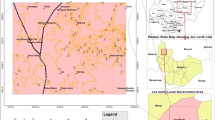Abstract
Water resources in Taiwan are unevenly distributed in spatial and temporal domains. Effectively utilizing the water resources is an imperative task due to climate change. At present, groundwater contributes 34% of the total annual water supply and is an important fresh water resource. However, over-exploitation has decreased groundwater availability and has led to land subsidence. Assessing the potential zone of groundwater recharge is extremely important for the protection of water quality and the management of groundwater systems. The Chih-Pen Creek basin in eastern Taiwan is examined in this study to assess its groundwater resources potential. Remote sensing and the geographical information system (GIS) are used to integrate five contributing factors: lithology, land cover/land use, lineaments, drainage, and slope. The weights of factors contributing to the groundwater recharge are derived using aerial photos, geology maps, a land use database, and field verification. The resultant map of the groundwater potential zone demonstrates that the highest recharge potential area is located towards the downstream regions in the basin because of the high infiltration rates caused by gravelly sand and agricultural land use in these regions. In contrast, the least effective recharge potential area is in upstream regions due to the low infiltration of limestone.











Similar content being viewed by others
References
Bierwirth PN, Welsh WD (2000) Delineation of recharge beds in the Great Artesian Basin using airborne gamma-radiometrics and satellite remote sensing. Report for the National Landcare Program, Bureau of Rural Sciences, Canberra, Australia, 33 p
Edet AE, Okereke CS, Teme SC, Esu EO (1998) Application of remote sensing data to groundwater exploration: a case study of the Cross River State, southeastern Nigeria. Hydrogeol J 6:394–404
El-Baz F, Himida I (1995) Groundwater potential of the Sinai Peninsula. Egypt, Project Summery, AID, Cairo
Freeze RA, Cherry JA (1979) Groundwater. Prentice-Hall, Inc., Englewood Cliffs
Greenbaum D (1985) Review of remote sensing applications to groundwater exploration in basement and regolith. Br Geol Surv Rep OD 85:36
Jaiswal RK, Mukherjee S, Krishnamurthy J, Saxena R (2003) Role of remote sensing and GIS techniques for generation of groundwater prospect zones towards rural development—an approach. Int J Remote Sens 24:993–1008
Krishnamurthy J, Venkatesa Kumar N, Jayaraman V, Manivel M (1996) An approach to demarcate groundwater potential zones through remote sensing and geographic information system. Int J Remote Sens 17:1867–1884
Lattman LH, Parizek RR (1964) Relationship between fracture traces and the occurrence of groundwater in carbonate rocks. J Hydrol 2:73–91
Leblanc M, Leduc C, Razack M, Lemoalle J, Dagorne D, Mofor L (2003) Application of remote sensing and GIS for groundwater modeling of large semiarid areas: example of the Lake Chad Basin, Africa. In: Hydrology of Mediterranean and semiarid regions conference, Montpieller, France. Red Books Series, vol 278. IAHS, Wallingford, pp 186–192
Leduc C, Favreau G, Schroeter P (2001) Long-term rise in a Sahelian water table: the Continental Terminal in southwest Niger. J Hydrol 243:43–54
Lin MS, Lin WH (1998) Explanatory text of the geologic map of Taiwan. Scale 1:50,000 Sheet 64. Central Geological Survey, Taiwan
Mukherjee S (1996) Targeting saline aquifer by remote sensing and geophysical methods in a part of Hamirpur–Kanpur, India. Hydrogeol J 19:53–64
Murthy KSR (2000) Groundwater potential in a semi-arid region of Andhra Pradesh-a geographical information system approach. Int J Remote Sens 21:1867–1884
NRSA (1987) Land and water resources survey of drought affected district-Kolar, Karnataka. Technical Report, National Remote Sensing Agency, Hyderabad
O’Leary DW, Friedman JD, Poh HA (1976) Lineaments, linear, lineations: some standards for old terms. Geol Soc Am Bull 87:1463–1469
Salama RB, Tapley I, Ishii T, Hawkes G (1994) Identification of areas of recharge and discharge using Landsat-TM satellite imagery and aerial photography mapping techniques. Hydrogeol J 162:119–141
Saraf AK, Choudhury PR (1998) Integrated remote sensing and GIS for groundwater exploration and identification of artificial recharge sites. Int J Remote Sens 19:1825–1841
Sener E, Davraz A, Ozcelik M (2005) An integration of GIS and remote sensing in groundwater investigations: a case study in Burdur, Turkey. Hydrogeol J 13:826–834
Shaban A, Khawlie M, Abdallah C (2006) Use of remote sensing and GIS to determine recharge potential zone: the case of Occidental Lebanon. Hydrogeol J 14:433–443
Shahid S, Nath SK, Roy J (2000) Groundwater potential modeling in a soft rock area using a GIS. Int J Remote Sens 21:1919–1924
Singh AK, Prakash SR (2002) An integrated approach of remote sensing, geophysics and GIS to evaluation of groundwater potentiality of Ojhala sub-watershed, Mirjapur district, U. P., India, http://www.GISdevelopment.net
Solomon S, Quiel F (2006) Groundwater study using remote sensing and geographic information system (GIS) in the central highlands of Eritrea. Hydrogeol J 14:1029–1041
Tweed SO, Leblanc M, Webb JA, Lubczynski MW (2007) Remote sensing and GIS for mapping groundwater recharge and discharge areas in salinity prone catchments, southeastern Australia. Hydrogeol J 15:75–96
Yen TP (1970) Structural analysis of the slate formation of Taiwan. Bull Geol Surv Taiwan 21:1–51
Yeh HF, Chang PH, Hsu KC, Lee CH (2007) Assessment of groundwater recharge in Chih-Pen and Jin-Lin Creek basins. In: Proceedings of 3rd conference on resources engineering in Taiwan, pp 1–15
Acknowledgments
The authors would like to thank the Water Resources Agency of the Ministry of Economic Affairs of the Republic of China, Taiwan, for financially supporting this research under Contract No. MOEAWRA0950416.
Author information
Authors and Affiliations
Corresponding author
Rights and permissions
About this article
Cite this article
Yeh, HF., Lee, CH., Hsu, KC. et al. GIS for the assessment of the groundwater recharge potential zone. Environ Geol 58, 185–195 (2009). https://doi.org/10.1007/s00254-008-1504-9
Received:
Accepted:
Published:
Issue Date:
DOI: https://doi.org/10.1007/s00254-008-1504-9




